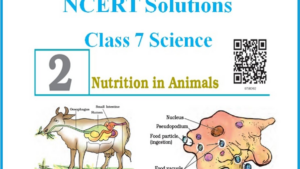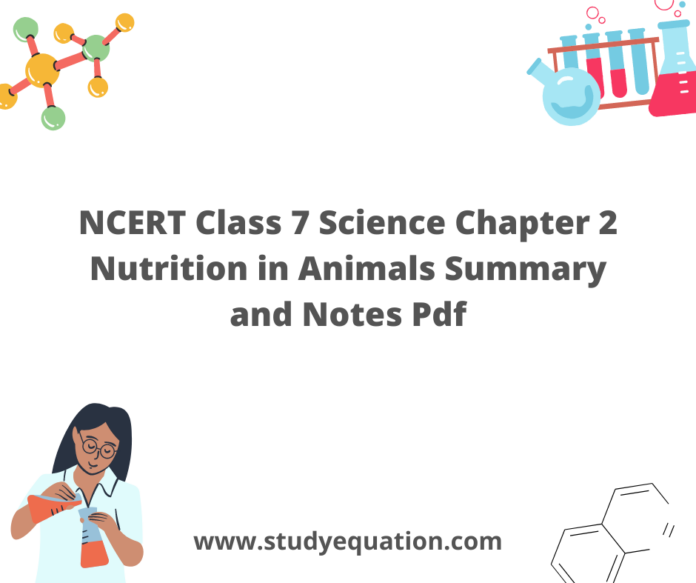The Class 7 Science Notes for Speedy Revision include NCERT Class 7 Science Chapter 2 Nutrition in Animals, which is available for free download. NCERT Class 7 Science Notes Chapter 2 on Animal Nutrition is available here. The Class 7 Chapter 2 Science Notes were prepared using the CBSE syllabus. Therefore, they may quickly download the notes and refer to them as needed. The fact that these notes are written in simple, understandable language and will assist the pupils in doing well is a benefit of using them. The fundamentals of animal feeding are explained in this chapter. It addresses subjects including human digestion, the digestion of grass-eating animals, and the feeding and digesting of amoebas, among others.

Table of Contents
NCERT Class 7 Science Chapter 2 Nutrition in Animals Introduction
All animals need food for energy, development, the healing of injured organs, and general body maintenance. Animal nutrition is the practice of an animal ingesting food and using it inside its body.
Animals obtain their food from plants directly or indirectly by consuming other animals that eat them; however, plants may manufacture their food through photosynthesis. In addition, some creatures consume both vegetation and other creatures. Animal nutrition covers nutritional needs, food intake methods, and how the body uses food.
Food products like carbohydrates are complicated compounds that the body cannot use. They are thus reduced to simpler compounds. The process of digestion involves dissolving complicated dietary components into simpler ones. Food may be digested in two different ways: physically (by chewing and crushing it in the mouth) and chemically (addition of digestive juices
to the food by the body itself).
NCERT Class 7 Science Chapter 2 Nutrition in Animals Summary
- All living things, including humans, need nourishment to develop, repair, and maintain their physical structures. Nutrition for animals includes:
Nutrition requirements - Food consumption
- and the body’s use
Different species consume food in various ways. For instance, bees and hummingbirds consume flower nectar; snakes devour their prey, etc.
Secretory glands and the alimentary canal make up the human digestive system. Different compartments can be created within the canal.
- the buccal cavity,
- an oesophagus or food pipe,
- stomach,
- small intestine,
- large intestine
- the anus.
- These digestive system components are all together. The digestive system comprises the digestive tract and its connected glands, including the pancreas, liver, and salivary gland.
The process of nutrition involves: - Consumption
- digestion
- assimilation
- egestion
The action of consuming food in the body is referred to as ingestion. Food is broken down during digestion into its primary constituents. Food digestion starts in the buccal cavity. Starch and other carbohydrates are processed in the buccal cavity. The stomach is where protein digestion begins. The bile produced by the liver, pancreatic juice from the pancreas, and digestive juice from the intestinal wall thoroughly digest all meal components in the small intestine. The blood vessels in the intestine’s wall now receive the digested food. Absorption is the term of this process. Blood arteries send the absorbing materials to various bodily organs, which are employed to construct complex materials, such as the proteins needed by the body. This is referred to as assimilation.
The regular elimination of feces through the anus is known as egestion. Animals that consume grass swiftly ingest the plant material stored as cud. Animals eventually chew on this when it returns to their mouths in little chunks. These animals are referred to as ruminants, and this process is known as rumination. The amoeba uses projections that resemble fingers to help it eat. In the food vacuole, the food is broken down.
NCERT Class 7 Science Chapter 2 Nutrition in Animals Notes
Various Methods of Consuming
Each type of organism or species has a unique mechanism for consuming food.
Bees and hummingbirds feed on plant nectar, human infants and certain other animals swallow their mothers’ milk, and snakes like the python eat the prey they have caught.
Animals that live in water filter nearby tiny food particles and eat them.
Digestion in Humans
- The digestive system in humans comprises the digestive tract and its connected glands.
- This is the whole route food takes through the body, beginning at the mouth and finishing at the anus.
- The digestive system comprises the stomach, esophagus, small intestine, and large intestine.
- The three main digestive glands are the salivary glands, liver, and pancreas.
Buccal Cavity
For humans, the beginning of the digestive system is the buccal cavity, sometimes referred to as the mouth.
It is made up of teeth and the tongue.
Teeth
Assist in breaking down food into tiny pieces during chewing.
The tongue is a fleshy, movable organ backward-attached to the buccal cavity’s surface.
Food digestion is assisted by saliva, which is released in the mouth.
Tongue
It is a fleshy, muscle-filled organ linked to the buccal cavity’s rear.
When chewing, it facilitates swallowing and assists in combining saliva with food.
We can distinguish between flavors due to taste buds on the tongue.
Esophagus or food pipe
The esophagus receives the food that is swallowed.
Its job is to move food and liquid from the mouth to the stomach once they have been swallowed.
Food is forced down due to movement through the food pipe’s walls.
Stomach
Then, it enters the small intestine in the direction of the opposite opening after obtaining food from the feeding pipe.
The stomach’s inner lining produces gastric mucus, hydrochloric acid (HCl), and other digestive secretions.
In the stomach, food gets churned into a semi-solid substance.
The gastric juice’s enzymes break down the meal.
Proteins may be partially digested with hydrochloric acid, which also destroys dangerous germs.
Small Intestine
- This 7.5-meter-long organ is tightly wound.
- It receives secretions from the pancreas and liver.
- The small intestine is where food is fully digested and absorbed.
- Villi are finger-like outgrowths on the inside of the gut walls.
- A thin network of blood arteries is present in each villus.
- Villi’s ability to absorb food is conveyed to the body through blood vessels.
large intestine
The small intestine is shorter and broader than this.
Its length is 1.5 meters.
The big intestine is where salt and water from undigested meals are absorbed.
The rectum is used to discharge out any leftover waste.
Fecal debris is occasionally removed through the anus (egestion).
Anus
The aperture at the end of the human digestive system is called the anus.
Egestion is the term used to describe the expulsion of feces from the large intestine through the anus.
Salivary glands and saliva
Around the mouth are three sets of salivary glands, which secrete saliva through salivary ducts into the mouth.
Salivary amylase and mucus are both present.
Food may quickly move through the food pipe thanks to mucus.
Salivary amylase is an enzyme that converts the starch in the diet into less complex carbohydrates.
Gallbladder
A little pear-shaped organ, the gallbladder, is located underneath the liver on the right side of the body.
Bile produced by the liver is kept there.
Ingestion
Ingestion is the process of ingesting food into the body.
Digestion
Digestion is how complicated dietary components are broken down into simpler elements.
In the stomach, there is only partial digestion, but in the intestine, there is complete digestion.
Small intestine Assimilation and Absorption
The food that has been digested is absorbed by the blood vessels that line the small intestine’s walls. This behavior is referred to as absorption.
Villi are many finger-like protrusions that line the inside of the small intestine walls.
Through blood arteries, the compounds that are ingested are sent to various body organs, which are used to construct complex molecules like proteins necessary for the body. This is called assimilation.
Grass-eating animals’ digestion
Animals that consume grass have a different digestive system than us.
Even when they aren’t eating, these creatures are constantly chewing.
They quickly ingest the grass and deposit it in the Rumen.
Cud is the term for the food partially digested by microorganisms in the Rumen.
Cud
Cud is the term for partially digested food returned from the Rumen into the mouth for further chewing.
Rumination
The procedure by which the cattle regurgitate previously eaten feed and masticate it a second time is known as ruminating.
Amoeba Feeding and Digestive Processes
Amoeba
Amoeba is a minute, one-celled creature that may be found in pond water.
Amoeba often alters its appearance and location.
Amoeba Digestion Procedures
Pseudopodia allow the amoeba to grab the food particles. Phagocytosis is the name of the process.
Thus, a food vacuole is formed, containing the food substance.
Digest juices are created when food passes through the cytoplasm and into the food vacuole.
The food is affected by them and broken down into simpler compounds, after which the digested meal is absorbed.
Undigested food is finally discharged into the surrounding water when the food vacuole opens to the outside.
NCERT Class 7 Science Chapter 2 Nutrition in Animals Pfd Download
Class 7 Science Chapter 2 Nutrition in Animals Conclusion
Animals go through a complicated process of nutrition that includes intake, digestion, absorption, and assimilation. Unused or unabsorbed food is then expelled from the body by egestion. Ingestion: The act of eating is referred to as ingestion. Different animals consume food in different ways.
Class 7 Science Chapter 2 Nutrition in Animals FAQ:
Q1.What are the digestive system’s primary components?
Answer. The mouth, pharynx (throat), esophagus, stomach, small intestine, large intestine, rectum, and anus are all parts of the digestive system.
Q2. What does “ingestion” mean?
Answer. The act of consuming food is referred to as ingestion.
Q3. As to why cows ruminate?
Answer. The cow regurgitates already ingested feed during rumination and continues to digest it. This physical procedure speeds up cows’ digestive rates, enabling them to consume more feed and provide more nutrients.





